3. 'ACT 2'
This second Act of Jodorowsky's 'The Holy Mountain' is the most dense, complex and will be talked about in TWO SECTIONS.
All commentary by Al Razutis except where attributed to stated sources.
ACT II - SECTION 1 ('The Alchemist and the Thief's Initiation - Transformation')
A panel of frames from The Holy Mountain by Jodorowsky, this section referred to as ACT 2 section 1
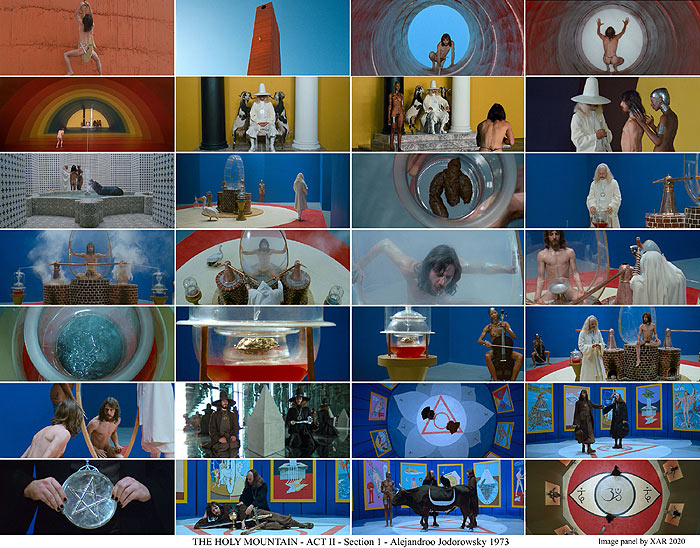
For no apparent reason except perhaps greed the character called the 'thief', who acts more like a sleepwalker than a conscious character (he mostly acts without expressed motivation, as if he is sleeping, sleepwalking) grabs the rope, ascends the tower, and enters the lair of the Alchemist (Jodorowsky) and his props, characters, and scenes.
They have a 'ritual' of a fight - which is phony yet is intended to convey weighty meaning (the power of the alchemist over adversaries and mastery of the body)... and once subjugated the thief follows tamely a number of 'procedures' (ritualized scenes, alluding to alchemical transformation, but explaining or revealing nothing.)
Alchemist: "Do you want gold?"
Thief: "Yes"
(They bathe the thief - first 'purification' to be followed by 'putrefaction'?)
Alchemist: "You are excrement, you can change yourself into gold"
What follows is pure 'invention': the 'thief' in a huge glass container with his 'sweat' (does he sweat? he certainly doesn't do any work here) providing the 'catalyst' for this 'transmutation' of his shit (literally) into 'gold' (literally)...
However, this is not transmutation, nor is it the philosopher's egg or the stone. An 'elixir' of sweat won't turn shit into 'gold', except through a sleight of hand and some clever filmic fx called 'dissolves'.
So the logic is? Well it's all about correspondences, invented allegory with props set in a laboratory that can only exist in a filmed stage. The thief is simply 'there' to be experimented on... he can't turn himself into anything. He's there along for the ride.
So, what about the ego?
Alchemist: "You broke the looking glass, now break the stone."
But not so easy?
The images of the panel of frames show a bit of this sleep walk through vaguely alchemical rituals, alluding to chemicals, tranformations, symbols, and unfortunately re-introducting more of the Tarot by way of some obscure astrology.
Everything is done with minimum emotion, or caricature of emotions, everything is strangely sterile and dead. We move from scene to scene without any clear guidance. We are supposed to make it up as we go, maybe that's the game, that's the show.
Is this alchemy? It the character portrayed and played by Jodorowsky an alchemists? Or are we in a stage show appropriated from sources long absent from the scene?
Of all the sections of the film, this second act is the most complex, lengthy, and prone to the greatest extravagances, and the greatest deceptions concerning alchemy.
We can call this the "OPUS" or the "work" of the alchemical transformation being undertaken here. But does this constitute a genuine alchemical 'opus'? Is not Jodorowsky merely cutting and pasting from classical symbols, alchemy, tarot here? Is this simply made-up ritual by the filmmaker Jodorowsky? And what does this transformation of the 'Thief' really imply? And where does it end us?
------------------
PLOT SUMMARY - ACT II -- SECTION 1 - Sourced from pp 13-15 -
Journal of Religion & Film, Vol. 19 [2015], Iss. 2, Art. 2
Breckenridge: A Path Less Traveled
Published by DigitalCommons@UNO, 2015 -
https://digitalcommons.unomaha.edu/jrf/vol19/iss2/2
"The second act begins when the thief encounters a tower with a single window at the top. From the window a hook with a bag of gold on it is lowered to the crowd, where a man at the bottom takes it and replaces it with a plate of food. The thief, driven by greed, abandons his limbless companion and grabs onto the hook and is raised to the window (the symbolism of him rising above the decadence of the city is precisely as obvious as it appears). Inside is the Alchemist who, after a brief exchange, takes on the thief as a pupil.
"The scenes that follow are among the most obfuscating in the film. They consist of a series of rituals the Alchemist takes the thief through that do not appear to be drawn from any major religion and for which even Cobb provides no explanation, which suggests they are purely of Jodorowsky's invention. For example, one such lesson has the Alchemist present the thief with a stone pillar and give him and axe, instructing him to break the stone. When the thief fails to do so after striking it repeatedly, the Alchemist takes the axe, strikes it on the top of the pillar, and it shatters, revealing a glass sphere, which the Alchemist takes and tells the thief,
Alchemist: "This stone has a soul formed by the work of millions of years."
Continue with Breckenridge analysis:
"To try to analyze the symbolism at work here and in the many other scenes that accompany it in this act would quickly prove tedious and futile, but there is a legitimate case to be made for focusing not on what they mean but on why we are witnessing them. The scenes become more comprehensible when we consider them simply as actions, which is to say when we consider the significance of the simple fact that we are witnessing the motions of these rituals. Nearly every major religion features complex and often meaningless rituals whose purpose is not in understanding why but simply in the doing. Many Buddhist mantras have no signified but instead are meaningless sounds whose repetition works to help clear the mind: their significance is in the act of chanting itself. In presenting us with nonexistent religious rituals, Jodorowsky makes us aware of the actions (we would not think twice if he showed us nuns in prayer, even though praying in Latin - a language few understand anymore - serves a similar function as a mantra) at the same time that this is also one of the more subtle rejections of conventional religion in the film, since the invented rituals tie in with an ongoing theme we see in the film of rejecting mainstream religion as a path to enlightenment. The endless parade of symbols, should you not wish to make the effort to interpret them all, can serve the same function: simply as images whose significance lies in not knowing what they mean.
"However, while Jodorowsky treats these fictitious rituals of his with great reverence, he also blasphemes nearly every major religion in the world with this film at the same. Many of his rituals are rooted in more traditional religious rituals but he tends to alter them in ways that insult their intentions. For example, when turning the Thief's excrement into gold, the Alchemist first wraps his hands and arms in strips of paper with words on them - a clear parallel to the Jewish practice of wrapping oneself in the text of the Torah before performing certain rituals, though to associate such a ritual with excrement is blasphemous. In essence, Jodorowsky walks every path of spirituality but at the same time treads none of them. It is also possible that we could see The Holy Mountain as a counterpoint to El Topo: where the latter shows us a path to enlightenment that ends in failure, The Holy Mountain gives us one that succeeds only because the characters
shrug off all traditional and contemporary notions of achieving enlightenment and also, in another departure from El Topo, more directly satirizes the culture the film comes out of." (Breckenridge)
It is useful to recall what CG Jung said in referring to the Opus and alchemy and the projection of psychological characteristics onto the work and the transformation.
https://www.jungiananalysts.org.uk/wp-content/uploads/2018/07/C.-G.-Jung-Collected-Works-Volume-12_-Psychology-and-Alchemy.pdf
(page 258)
"2. THE PSYCHIC NATURE OF THE ALCHEMICAL WORK
-- I. THE PROJECTION OF PSYCHIC CONTENTS
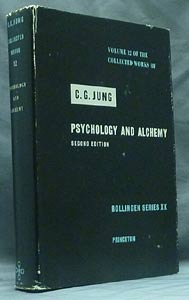
"[342] The alchemical opus deals in the main not just with chemical experiments as such, but with something resembling psychic processes expressed in pseudochemical language.1 The ancients knew more or less
what chemical processes were; therefore they must have known that the thing they practised was, to say the least of it, no ordinary chemistry.
"[345]...The real nature of matter was unknown to the alchemist: he knew it only in hints. In seeking to explore it he projected the unconscious into the darkness of matter in order to illuminate it. In order to explain the mystery of matter he projected yet another mystery - his own unknown psychic
background - into what was to be explained: Obscurum per obscurius, ignotum per ignotius! This procedure was not, of course, intentional; it was an involuntary occurrence." (CG Jung)
-- Psychology And Alchemy, C.G. Jung,
2nd Edition, pdf [ page number ] from this source:
https://www.jungiananalysts.org.uk/wp-content/uploads/2018/07/C.-G.-Jung-Collected-Works-Volume-12_-Psychology-and-Alchemy.pdf
It is useful to recall what Antonin Artaud said about the Alchemical Theatre.
"All true alchemists know that the alchemical symbol is a
mirage as the theater is a mirage. And this perpetual allusion to the materials. and the principle of the theater found in almost all alchemical books should be understood as the expression of an identity (of which alchemists are extremely aware) existing between the world in which the characters, objects, images, and in a general way all that constitutes the virtual reality of the theater develops, and the purely fictitious and illusory world in which the Symbols of alchemy are evolved.
"These symbols, which indicate what might be called philosophical states of matter, already start the mind on its way toward that fiery purification, that unification and that emaciation (in a horribly simplified and pure sense) of the natural molecules; on its way toward that operation which permits, by sheer force of destructive analysis, the reconception and re constitution of solids according that equilibrium of spiritual descent by which they ultimately become gold again."
-- The Theater and Its Double by Antonin Artaud --
Chapter III - The Alchemical Theater, pp 49-50
Brekenridge -- www.alchemists.com/fb/jodo-path-less-traveled.pdf
Jung -- http://www.alchemists.com/fb/psychology_alchemy_jung.pdf
Artaud -- http://www.alchemists.com/fb/theatre-its-double.pdf
--------------------------------------------
ACT II - SECTION 2 ('Alchemy, Astrology, Tarot and Thieves Thereof')
The Holy Mountain, 1973 -- Act II, Section 2 --
"I attach 7 panels of frame grabs from the movie which pertain to the 7 'scenes' which Jodorowsky presents in sequential order in this Act II 'Section 2' as I call it.

"
This wasn't just a film, but a life in the performance arts, a book, a cult scene, and what I term a 'public misunderstanding' of alchemy, and all things related to esoteric knowledge. Certainly this film had 'surrealist' elements in it. It was financed by the Beatles and their manager Klein to the tune of a 'million dollars' because of Jodorowsky's cult status (which is covered in the beginning instalments of my revue / analysis) in the Midnight Cinemas of his film 'El Topo', a religious 'western' which had a lot of 'biblical references'.
"In this film, Jodorowky (playing the Alchemist, the magus, the director) explicitly uses, and in my mind 'abuses', the concepts and practices of alchemy, as well as the Tarot, Astrology and other hermetic practices. My evaluation is based on including other sources (such as CG Jung, 'Psychology and Alchemy', Antonin Artaud 'The Theater and its Double - Chapter III 'The Alchemical Theater', and writings by other authors, including Cobb who wrote the book with Jodorowky titled 'Anarchy and Alchemy' which dealt extensively with his films.
"
The 'planets' are depicted as thieves engaged in doing evil against the common people. Certainly this is the moral position here which depicts gross, exaggerated and grotesque carrying ons by weird people flying the 'flags of planets' but nothing more. Certainly these 'thieves' are arbitrarily connected in name and logo only to 'the planets'. I saw no astrology, only vague imitation in them. I also saw the narrative as an excuse for wild set designs, constumes, make up, and many of these vignettes and planets were perverse creatures who enjoyed either torture or fetish sex on their way to murder. What planets in the classical scheme of alchemy were written like this? None that I ever came across.
"
Many females here in this section are depicted naked, some humiliated, most of them servile, except that repulsive version of Gaia. This suggests that the target audience is 'male'. Some overtones presented in some sections are explicitly homoerotic, like Axon and the castration of little boys, and the army of such he commits to murder and desctruction. What is the message here? We're going to the Holy Mountain for one. Nothing much of a conclusion is to be found here.
"
How does this tie in with alchemy, astrology, tarot of the hermetic sciences? Which tradition does this follow from? These questions remain unanswered throughout this moralizing, satirizing section of the film, with the initiate thief only a bystander in this series of vignettes of those creations of Jodorowsky will finally send to the mountaintop with him.
" (AR)
------------------------
Quoted descriptions that follow are sourced from pp 13-15, Journal of Religion & Film, Vol. 19 [2015], Iss. 2, Art. 2, Breckenridge: A Path Less Traveled - Published by DigitalCommons@UNO, 2015
https://digitalcommons.unomaha.edu/jrf/vol19/iss2/2
"Perhaps the most celebrated sequence of the film comes after the Alchemist has taught the Thief much of what he needs to know. He explains that they will have a number of companions on their journey, "thieves like you, but on another level. They are the most powerful people on the planet, industrialists and politicians." What follows is a series of vignettes as we are introduced
to all seven of them one at a time. Each of them is connected to one of the planets (Venus through Pluto with none representing Earth) and Jodorowsky weaves quite an intricate connection between the eight thieves and the god to which each of their planets corresponds."
"In addition to the rather novel vignette structure, this sequence is notable for its heavy satire, which is somewhat atypical of Jodorowsky. We do see some elements of satire elsewhere in The
Holy Mountain, but through the whole of Jodorowsky's work satire is something he is rarely inclined to engage in.
Two panels of frames from The Holy Mountain by Jodorowsky, this section referred to as ACT 2 section 2

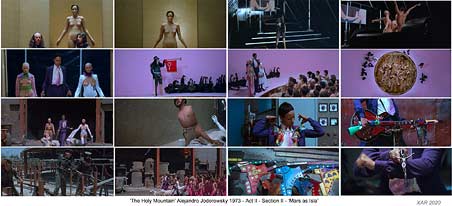
"At first the connections are obvious: Fon (Juan Ferrara) represents Venus and he heads a massive beauty and
fashion empire while Isla (Adriana Page) represents Mars and is an arms manufacturer (hopefully the reversal of the traditional gender roles has not escaped the reader).
"Fon (Venus), is in charge of a beauty empire run by his father, who is deaf, blind and mute and makes executive
decisions by sticking his finger into the vagina of his wife's mummified corpse, giving a yes if it is wet and a no if it is dry (one imagines his father must be a rather negative person). They sell
prosthetic faces and muscles that allow the wearer to look however they want and have pioneered animatronic technology that allows people to present themselves as they wish in death, a process
Fon demonstrates by having a dead priest give a blessing and a dead stripper perform an erotic dance. Aside from the undeniably original presentation, it is a fairly standard critique of fashion:
emphasizing vanity and superficiality and run by a man who is literally blind, deaf and out of touch with the world." (Breckenridge)
But as we move further out
in the solar system the connections become more esoteric. Understanding Klen's (Burt Kleiner) connection to Jupiter requires the viewer to recall that Jupiter, in Roman mythology, was often
associated with merrymaking, and Klen is a manufacturer of art and sex toys, while the children's toymaker Sel (Valerie Jodorowsky) represents Saturn, who was the father of the Gods.
Two panels of frames from The Holy Mountain by Jodorowsky, this section referred to as ACT 2 section 2

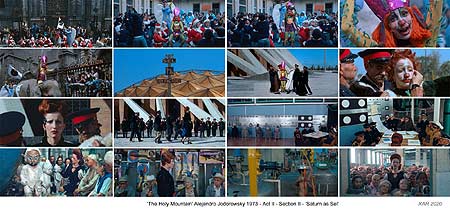
"The satire generally runs on this level but some set pieces are a little more creative in their satire. In Klen's (Jupiter) sequence, after taking us on a tour of the factory where he manufactures
avant-garde art (which he mass produces by having workers dip their butts in paint and rub them on canvases) he introduces us to his newest invention: a giant cubic box with a vaguely vaginal
opening on the front that is designed to test how good a lover someone is (which he never names but we can actually learn from the song list for the film's soundtrack is called the Fuck Box). Klen
explains: "We created a love machine. To make it live the spectator has to work with it, guide it, receive it, give himself in the act of love." Klen first has his chauffeur demonstrate how it works
by handing him what can only be adequately described as a giant electro-magnetic dildo:
Klen: "With this electronic rod, he will rub its mechanical vagina. The skill of the spectator
will determine the machine's ability to reach a climax."
"The chauffeur tries to force the rod into the machine, which causes it to vibrate slightly but little else. Klen takes the rod and hands the rod over to his mistress:
Klen: "My chauffeur is a bad lover. He didn't know how to satisfy it. But this woman, I know her techniques very well, will produce the electronic orgasm."
"The woman approaches the box more gently and as she does so, it begins to unfold and expand to fill the room, emitting a series of electronic beeps that grow louder and more intense until a baby
robot drops from between its legs, which the mother robot begins to cradle in its arms while singing a digital lullaby." (Breckenridge)
Two panels of frames from The Holy Mountain by Jodorowsky, this section referred to as ACT 2 section 2
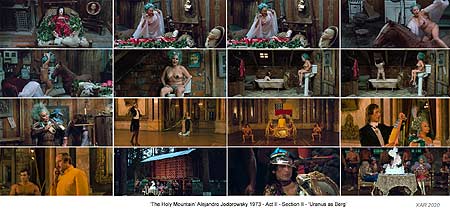
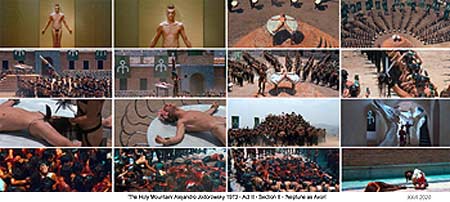
"Berg
(Nicky Nichola) is a financial advisor to the President (which president is not made clear but there are obvious connotations of a generic Latin American dictator), but Cobb suggests his celestial
connection is not through his work, as it is with the others, but through his relationship to his mother, which is the focus of his vignette, as Uranus was the son of Gaia.
"Axon (Richard
Rutowsky) is Neptune and chief of police (as well as the instigator of the suppression of the student rebellion we witness early in the film) and Cobb informs us that modern astrologers associate
Neptune with illusion and deception, which can be seen as representative of a man who ostensibly upholds justice but in reality is a ruthless suppressor of it.
A panel of frames from The Holy Mountain by Jodorowsky, this section referred to as ACT 2 section 2
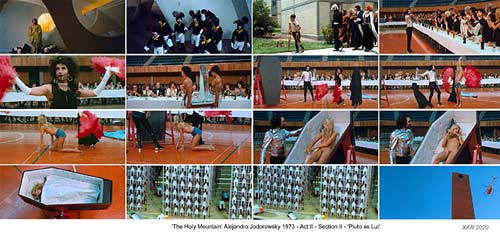
"Lut (Luis Loveli) is a Real Estate
mogul and representative of Pluto, which is perhaps not quite as esoteric as some of the other thieves, as there is a certain twisted logic in having a man who designs apartments for the working
class (the focus of his vignette) represented by the god of the underworld. In his narrative he is creating a 'revolutionary' set of apartments for the working class man, which are quite literally
nothing but coffins suspended in towers that would be built in huge blocks." (Breckenridge)